Warbirds Over Delaware 2012
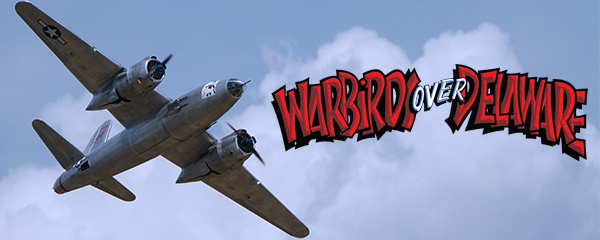
Written by Scott McClurg Digital exclusive event coverage on ModelAviation.com Aslo featured in the January 2013 Model Aviation tablet app. “Best day ever! This is epic!” shouted a young boy behind me at the start of Electric Mayhem on the fourth day of Warbirds Over Delaware (WOD) 2012. I can understand. I felt the same way on my first day at WOD in 2010—and half the event had been rained out that day!
WOD is an AMA and International Miniature Aircraft Association (IMAA) event and it’s one of the largest, oldest, and most-respected events of its type. It started in 1992 and consisted of just a handful of friends who got together to fly their large warbirds. It has since grown to be a fun-fly and daily air show with 185 pilots, roughly a dozen vendors, and more than 4,000 spectators.
To fly, an airplane must be a Scale model of a military aircraft from any point in any country’s history. It must also meet the IMAA’s minimum requirements for size: 60-inch wingspan or 1/4 scale (whichever’s smaller) for airplanes with two or more wings, and 80-inch wingspan or 1/4 scale (again, whichever’s smaller) for monoplanes.
Of course, this is just the starting point. They get much bigger than that. How big? How about a 1/2-scale Cub, or a B-29 with 20-foot wingspan?
WOD attracts some of best builders and pilots in the country. This year’s pilots included Mac Hodges, Paul LeTourneau, Frankie Mirandes, Adam Lilley, Dave Wigley, Jerry McCallum, and Ron and Joan Liska.
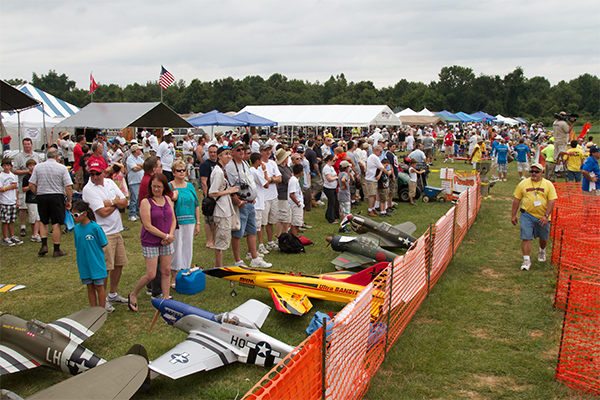
Saturday had a great turnout. Airplanes (L to R): Bill Fairweather’s P-47, Mike Ronig’s P-51, the Malchione’s Ultra Bandit, and Vinnie Damiani’s Zero and P-40.
WOD 2012 officially ran from Wednesday, July 11 through Sunday, July 15. Of course, that didn’t stop some of its more enthusiastic pilots from showing up and flying even earlier. By early afternoon on Tuesday, Mark Ward, and Jim Stanton, from Tidewater RC’s Ghost Squadron in Chesapeake, Virginia, had already set up their canopy, assembled several aircraft, and had their 1/4-scale Sopwith Pup in the air!
This is how WOD has grown to its current five-day run. Roughly 15 years ago, when Dave and Pete Malchione became CDs for WOD, it was only a three-day event. Each year, pilots arrive earlier and Delaware R/C makes sure the field is ready for them.
Pilots come from far and wide at attend. Chip Konig made the trip from Boca Raton, Florida; Paul Letourneau came from Oconto, Wisconsin; Frankie and Ricardo Mirandes, and their friend Ramón Medina brought three Giant Scale airplanes all the way from San Juan, Puerto Rico; and Ted Galbraith flew 3,500 miles from Essex, England, to attend. Ted has come every year for the last six or seven. It wasn’t practical for him to bring any of his own airplanes, so he borrowed Sal Calvagna’s Polikarpov I-16.
Cool and Calm
The weather for WOD couldn’t have been better. Just in time for the event, the heat wave that had made Delaware residents miserable for weeks dropped to the middle 80s and the winds dropped to almost nothing. For most of the spring and summer, the same field has experienced sustained winds of 15-20 mph, easily gusting to 30 mph, nearly every day. And the day after WOD, the winds returned as if they never left.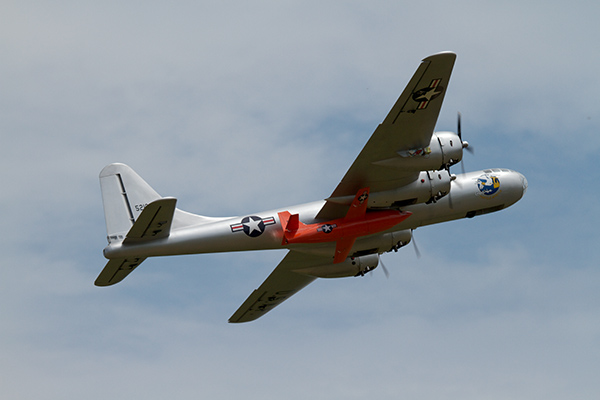
With its 20-foot wingspan, Team Hodges’ B-29 is not to be missed.
Amazing Aircraft
With hundreds of airplanes to choose from, it seems impossible to only choose one as the best at the event, but there were several this year that truly stood out.Team Hodges returned this year from Georgia with its amazing B-29 and Bell X-1. If you've never seen these aircraft, then it’s worth the trip to Delaware to see them fly. The B-29 has a 20-foot wingspan and is modeled after the Fertile Myrtle. Its four DA-100 motors put out 40 horsepower, which pilot Mac Hodges used to point the approximately 100-pound aircraft vertically and hover it.
Paul LeTourneau’s 19-foot B-26, with its amazing scale detail, powerful twin DA-100 engines, and working bomb drop, was another crowd-pleaser. It looked great on the ground and absolutely real in the sky.
Dave Wigley brought his 100-inch Westland Wyvern to WOD this year. Dave used this amazing model to take home the coveted title of Mr. Top Gun two years in a row. The Wyvern was built to 1/5 scale from Dave’s own drawings.
Powered by a BME 100 with a custom propeller shaft extension, the plans simulate the full-scale Wyvern’s counterrotating propellers by having a powered rear propeller and a free-wheeling front propeller. The combination of engine and propellers gave the Wyvern a fantastic sound unlike anything else in the air.
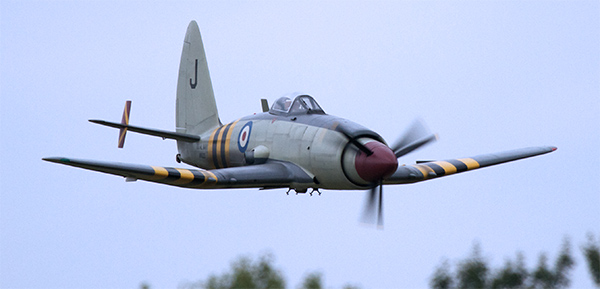
Dave Wigley’s Westland Wyvern makes a photo pass.
Frankie Mirandes, his son Ricardo, and friend Ramón Medina brought three aircraft that they competed with this year at Top Gun: a Focke Wulf 190 powered by a Mochi 150, and built from a Meister Scale kit by Ramón Medina; a Douglas Skyraider built by Ramón Medina using Ziroli plans; and a Provost TM 5 build by Frankie and Tony Vega and powered by a JetCat P160 turbine. The Provost took third place in the unrestricted category at this year’s Top Gun.
Halftime Show
On Friday and Saturday, WOD closed the field to normal flight to present an air show. The show began with pilot Adam Lilley taking to the skies as “Captain Anonymous,” playing the role of a hilariously inept student pilot on his first flight. Adam demonstrated remarkable precision and daring as he flew his airplane within arm’s reach of the ad banners, trees, and tall reeds at the far end of the runway.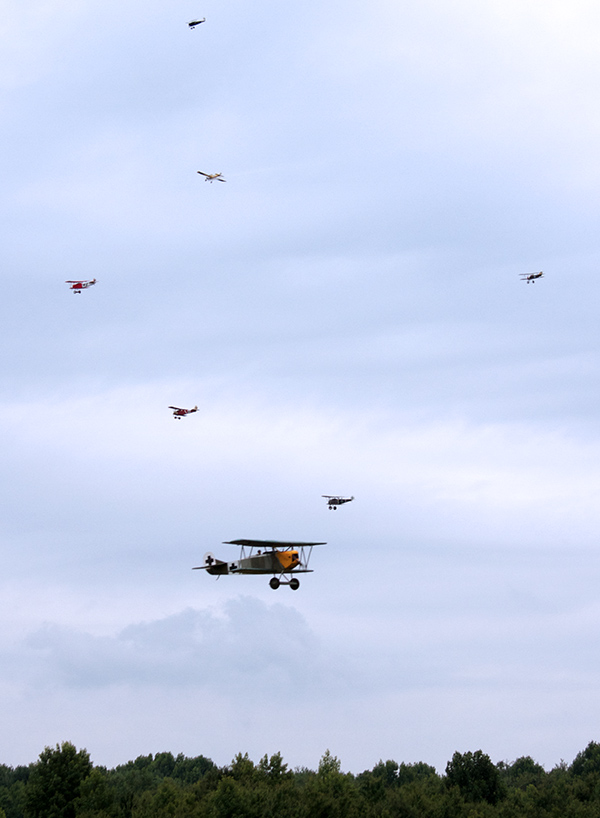
Having “accidentally” lost his left wheel early in the performance, he ended his show by making a three-point landing on the tail wheel, right wheel, and right wingtip. Then, he used his left landing gear as a pivot as he burned circles on the runway.
Next up was the World War I Gaggle, when all the pilots of WW I aircraft were invited to take to the air. Everywhere you looked, the sky was filled with aircraft as 22 models flew together.
The WW I Gaggle has been a tradition for years at WOD, but something new was added: a WW II Gaggle. A select group of skilled pilots was invited to fly together. Although there were only half as many aircraft in the WW II Gaggle, the added speed for the more modern airplanes made the show every bit as exciting.
Remember when I mentioned that Mac Hodges took his B-29 up and hovered it? He did this twice each day on Friday and Saturday as part of the halftime show. He even put on his show Thursday, although there wasn’t an official halftime show that day. But I’m getting ahead of myself.
Before Mac’s 3D performance, he used the B-29 to carry the Bell X-1 to altitude and dropped it. Buddy Kurtis then flew the X-1 to treetop level, pointed it at the sky, and let rip its powerful rocket motor. The X-1 shot straight for the sky before gliding back to the ground.
Buddy, being a 3-D pilot, couldn’t help but roll it a few times first. During the performance, Sam Williams played the critical role of spotter and Charlie Evans borrowed the microphone from Fast Eddie, the WOD announcer, and narrated the performance.
The halftime show ended Friday with Dave Malchione Jr. performing a beautifully choreographed aerobatic performance with his 200-mph Ultra Bandit jet. The performance was dedicated to Tony Malchione, Dave Jr.’s grandfather, Tony Wilford, Carl Hauger, Carl Cantera, Phyllis Crane, and Graham Lomax.
Saturday’s halftime show was even more impressive, with an aerobatic performance by Frankie Mirandes with his Jet Provost, a simulated torpedo run by Dave Wigley in his Westland Wyvern, and Paul LeTourneau flying his B-26 in formation with Dave Malchione Sr. and Jr. flying their twin Corsairs.

Jerry McCallum starts his 1/2-scale L-4 Cub. Jerry finished it four years ago after a three-year build.
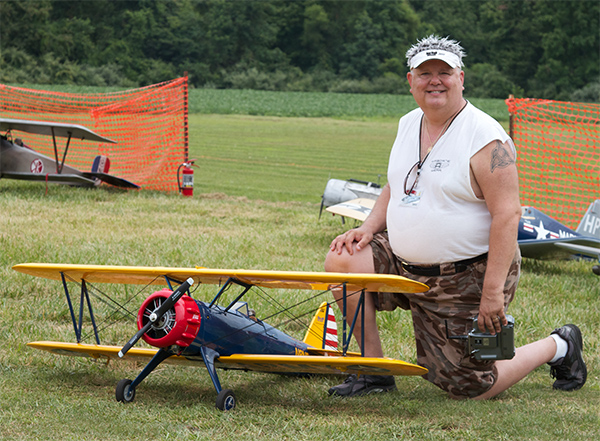
Ken Karpinski with his award-winning 1/5-scale model of the PT-17 Gus McCloud flew to the North Pole in April 2000.
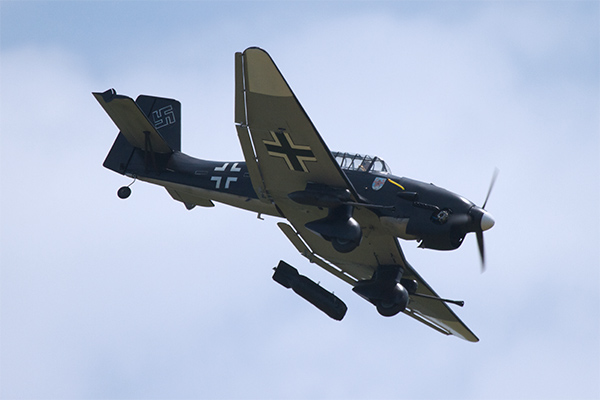
Jim Stanton makes a bombing run in his Stuka. Jim came from Chesapeake VA and is a member of Tidewater RC’s Ghost Squadron.
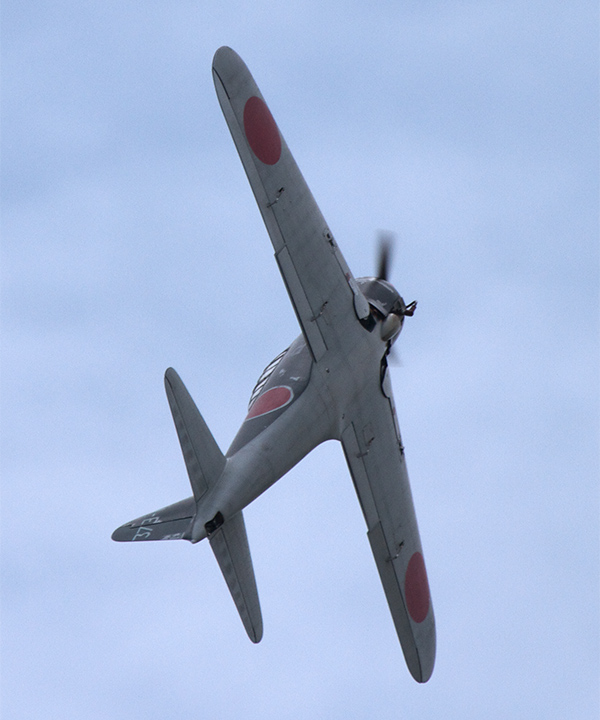
Ron Preston, from the Sky Hawks in Long Island NY, flies this Yelllow Aircraft A6M5 Zero powered by a Ziroli G-38.
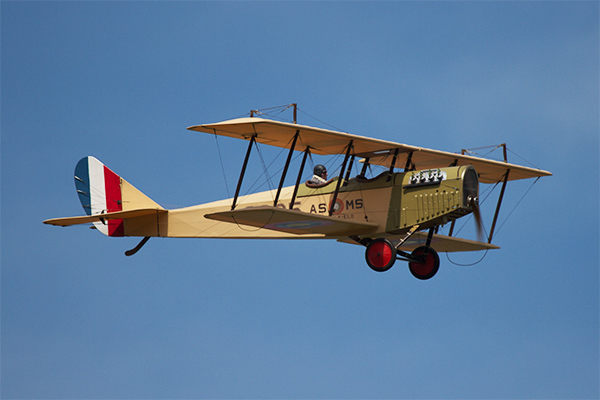
Ron Liska’s beautiful, scratch-built Curtiss JN-4 Jenny has a 150-inch wingspan. Its markings (Kelly Field) were to honor his wife Joan’s grandfather, who was a mechanic on the Jenny at Kelly Field in Texas during WW I.
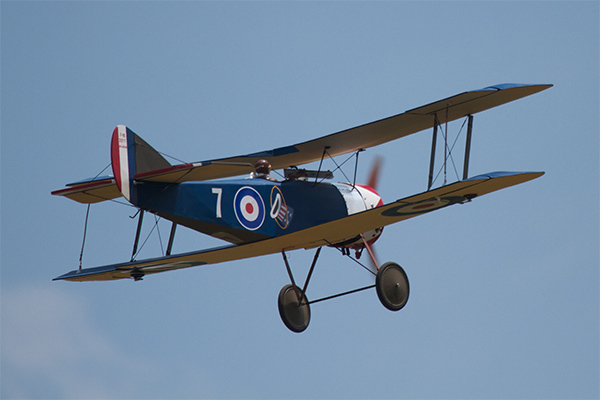
Tidewater R/C members were the first to fly this year with this beautiful Sopwith Pup. Pilots from last year may remember it with a green scheme. After a dogfighting incident earlier this year, the Ghost Squadron decided to paint it blue.

Scott Bonavo’s turboprop-powered Tucano looked and sounded incredible.
Daring, Skill, and a Bit of Luck
At any event this large, it’s almost inevitable that a few airplanes will be lost. Engines and receivers fail, winds gust at exactly the wrong moment, and occasionally pilots just make mistakes. This year, there appeared to be four near or total losses (all with no injuries to pilots or spectators), but perhaps more impressive were to two near accidents that turned into miraculous saves.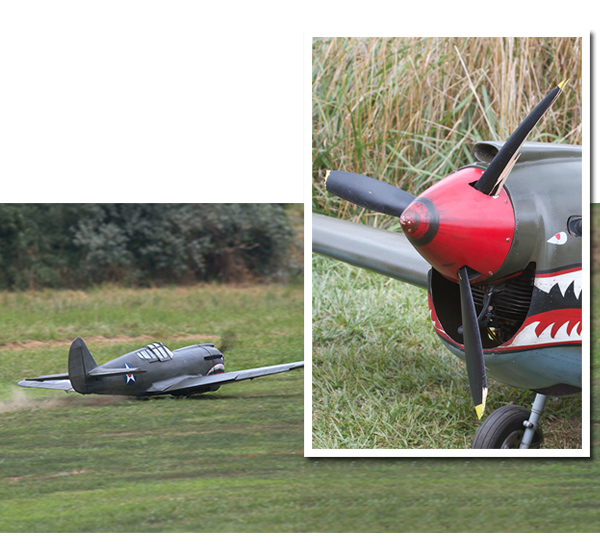
Adam Lilley’s lowest pass yet. Inset Above: The aftermath. The most amazing part was that Adam easily flew two victory laps on that propeller.
Chris Petriccione and Mark Castiglione from North Haven, Connecticut, were flying their twin P-51s in formation and had just finished a low-altitude, high-speed pass over the runway, climbed, and were pulling a high-G turn when Chris lost his engine. And it didn’t just stall.
His airplane went left, but his engine kept going straight, turning his large, fast fighter into a very tail-heavy glider. Chris kept turning left and guided his model to land in the tall grass right just beyond the runway. Thinking quickly, he deployed his flaps at the last second and made a soft, controlled landing with the gear up. All things considered, there was relatively little damage to the aircraft beyond the nose.
In the second incident, “Captain Anonymous” Adam Lilley was making in incredibly low pass over the runway with his 1/4-scale P-40 when he misjudged his altitude by just a few inches. Unfortunately, he only had a few inches. He pulled up hard just before impacting hard and bouncing back up.
It looked as though that was enough to protect the propeller. Adam proceeded to make two victory laps and he later admitted that during those laps, his airplane “seemed a bit underpowered.” When he landed, we saw the truth. Of the three blades his propeller had, two had lost the tips and the third was only half of its former self after it split lengthwise. Adam couldn’t have been more proud.

WOD staff assists in the recovery of Chris Petriccione’s P-51.

Pilot Chris Petriccione (dark blue) assesses the damage.
AMA and IMAA Leaders Came
During the last 21 years, IMAA President Frank Fels has only missed one WOD event. He wasn’t the only leader from the IMAA in attendance. Six of IMAA’s Assistant Directors turned out, including Mark Smith from Salisburg, North Carolina, Andy Kane from Silver Spring, Maryland, Harry Lodovico from Egg Harbor Township, New Jersey, Harold Erhke from Atco, New Jersey, Rick Andrese from Sussex, New Jersey, and Ken Karpinski from Philadelphia.The AMA had a large contingent of leaders including AMA President Bob Brown from Bradford, Pennsylvania, Executive Director Dave Mathewson from Muncie, Indiana, Associate Vice President (AVP) Jay Marsh from High Point, North Carolina, AVP Hank Mausolf from Fredericksburg, Virginia, AVP Rick Moreland from Edgewater, Maryland, and several others. They were met at WOD by AVP John Kirchstein, who lives in Newark, Deleware, and is the President of the Delaware R/C Club.
Awards
IMAA President Frank Fels surprised nearly everyone at the beginning of Saturday’s halftime show by making a special presentation. He began by presenting John Kirchstein with a District IV Appreciation Award for the Delaware R/C Club in honor of his time and service. Next, he presented two rather surprised CDs, Dave and Pete Malchione, with IMAA District IV Distinguished Service Awards. “These guys and the crew they that they have behind them...this is one of the nicest events that we could find.”Following Frank’s presentation, Mark Weiss, secretary of the Delaware R/C Club, made one of his own. “You know, these people can fly planes anywhere, but they come here, and they wouldn't come here if the people running this event weren’t the quality of David and Pete,” Mark said, just before presenting Dave and Pete Malchione with Lifetime Achievement Awards from the Delaware R/C Club, including two beautifully engraved plaques.
Pete jokingly responded, “What do we get next year?” Mark responded by explaining the second half of the award, a waiver of all future dues. After receiving his award, Dave Malchione took the microphone, turned to the assembled pilots, and said, “And thank you. Without you, there is no show, so, thank you.”
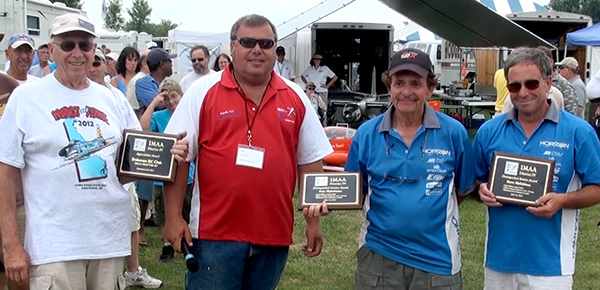
John Kirchstein, Frank Fels, Pete Malchione, and Dave Malchione Sr.
Looking for More?
To see videos and many more photos, or to post your own, visit WOD on Facebook and Flickr: facebook.com/WarbirdsOverDelaware; flickr.com/groups/warbirdsoverde.And for information about next year’s WOD, visit www.WarbirdsOverDelaware.com.

Similar Articles
|






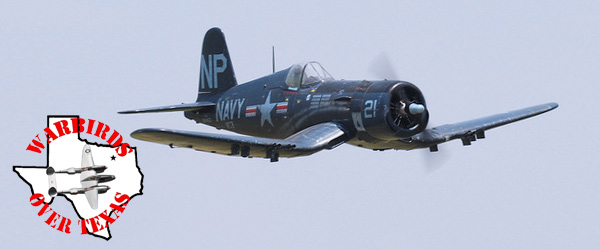
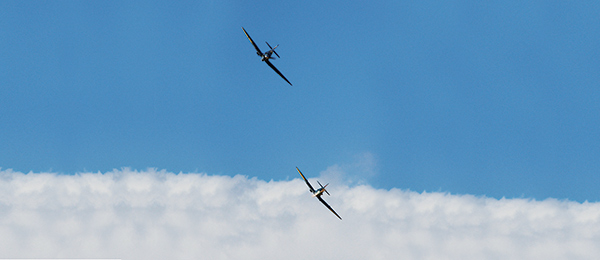





1 comments
safety!
Add new comment